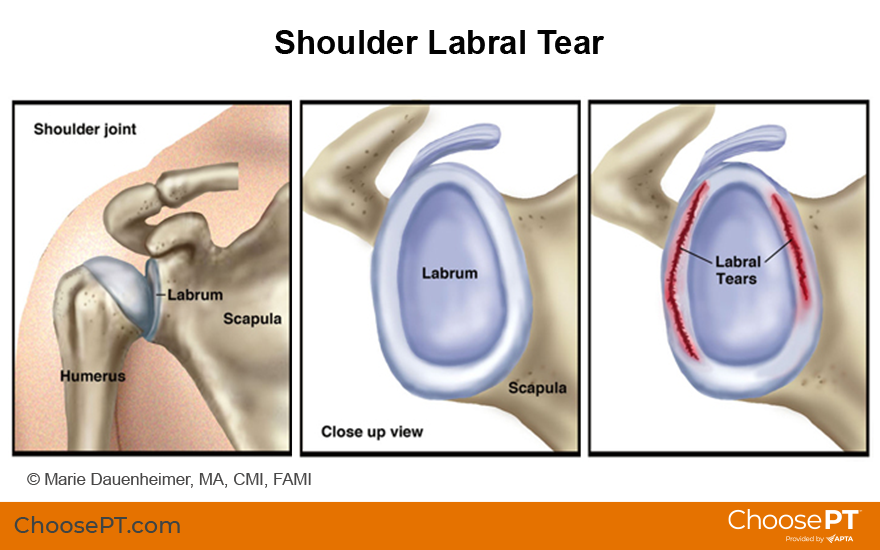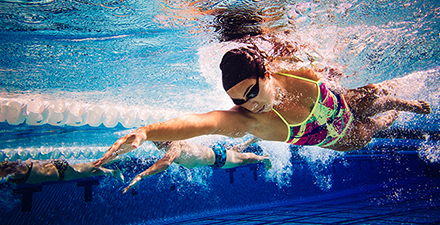Physical Therapy Guide to Shoulder Labral Tear
A tear in the shoulder labrum, or "labral tear," is a common injury to the shoulder. The labrum is the ring of cartilage that surrounds the base of the shoulder joint. A labral tear can cause significant pain. It also may make it hard to move your arm. A labral tear can occur from a fall or repetitive work activities or sports requiring you to use your arms above your head. Some labral tears can be managed with physical therapy. In severe cases, surgery may be required to repair a torn labrum.
Physical therapists are movement experts. They improve quality of life through hands-on care, patient education, and prescribed movement. You can see a physical therapist directly for evaluation and treatment without a physician’s referral.* To find a physical therapist in your area, visit Find a PT.
*A referral may still be required by your insurance policy, corporate policies, or state practice laws (some states limit the type of treatment or number of visits without a referral).
What Is a Shoulder Labral Tear?
The ring of cartilage called the glenoid labrum provides extra support for the shoulder joint, helping to keep it in place. A shoulder labral tear occurs when part of this ring is disrupted, frayed, or torn. Tears may lead to shoulder pain, an unstable shoulder joint, and, in severe cases, shoulder dislocation. Likewise, a shoulder dislocation can result in labral tears.
When you think of the shoulder joint, picture a golf ball resting on a tee. The top of the humerus (upper arm bone) is like the ball, and the glenoid (shallow socket on the shoulder blade) is like the tee. The labrum provides a rim for the socket (golf tee) so that the humerus (golf ball) does not easily fall off. If the labrum is torn, it is harder for the humerus to move correctly in the joint. The end result could be pain, weakness, or further injury to the shoulder joint.
Because the biceps tendon attaches to the shoulder blade through the labrum, labral tears can occur when you put extra strain on the biceps muscle, such as when you throw a ball. Tears also can result from pinching or compressing the shoulder joint when raising the arm overhead.
There are two types of labral tears:
- Traumatic tears. These usually occur because of a single incident. Examples include a shoulder dislocation or a heavy lifting injury. Weightlifters, gymnasts, and construction workers who use their arms overhead are more likely to experience traumatic labral tears. Activities like striking a hammer or swinging a racquet, where impact occurs at a distance from the shoulder and falling on an outstretched arm, also can cause a traumatic tear.
- Nontraumatic tears. This type most often occurs due to muscle weakness or repetitiveness. When the muscles that stabilize the shoulder joint are weak, more stress is put on the labrum, leading to tears. Some people with nontraumatic tears tend to have more "looseness" or hypermobility throughout all their joints. This looseness might be a factor in the development of a tear.

How Does It Feel?
A shoulder labral tear may cause you to feel the following:
- Pain over the top of your shoulder, and possibly pain in the back of the shoulder or down into the biceps area.
- "Popping," "clunking," or "catching" with shoulder movement. A torn labrum has "loose ends" that get flipped or rolled within the shoulder joint during arm movement. These loose ends can also become trapped.
- Shoulder weakness, often on one side.
- The feeling that your shoulder joint will pop out of place.
How Is It Diagnosed?
Not all shoulder labral tears cause symptoms. In fact, when tears are small, many people function without any symptoms. However, healing can be difficult due to the lack of blood supply available to a torn labrum. A shoulder with a labral tear may pop or click without pain. But if the tear progresses, it will likely lead to pain and weakness.
If your physical therapist suspects a labral tear, they will review your health history, ask about your daily, work, and sport activities, and test the condition of your labrum. They may gently place your shoulder in positions that recreate some of your symptoms, such as "popping," "clicking," or mild pain. These tests will help your physical therapist determine whether your shoulder joint is unstable. They may request an MRI to confirm the diagnosis. Some labral tears can be hard to diagnose with certainty without arthroscopic surgery. Your physical therapist may also consult with an orthopedic surgeon if necessary.
How Can a Physical Therapist Help?

Physical therapy is the usual treatment for shoulder labral tears with minor symptoms. Your physical therapist will educate you about positions and activities to avoid. They will tailor a treatment plan for your recovery based on your needs. Your treatment may include:
Manual therapy. Your physical therapist may provide gentle manual (hands-on) therapy to decrease your pain and begin to restore your shoulder movement.
Strengthening exercises. Improving the strength of the shoulder muscles will help you decrease stress on the torn labrum and allow for better healing. Your physical therapist may guide you through shoulder rotation exercises that target the shoulder-joint muscles, as well as shoulder-blade (scapular) exercises to provide stability to the shoulder joint itself.
Stretching exercises. A muscle imbalance or decreased flexibility can result in poor posture or too much stress on the shoulder joint. Your physical therapist may prescribe stretching exercises to improve the function of the muscles surrounding the shoulder. These may include gentle stretches of the chest muscles. They also may introduce middle-back (thoracic) stretches. These allow your body to rotate or twist to the side, so the shoulder joint doesn't have to stretch further to perform tasks like swinging a racquet or golf club.
Postural exercises. Your physical therapist will assess your posture and teach you specific exercises to ensure that your shoulders are properly positioned for daily tasks. A forward-head and rounded shoulder posture puts the shoulders at risk for injury.
Education. Education is an integral part of any physical therapy treatment plan. Your physical therapist will help you understand your injury, the reasons for modifying your activities, and the importance of doing your exercises to decrease your risk of future injury.
Home exercise program. A home exercise program is an important companion to treatment in the physical therapy clinic. Your physical therapist will identify the stretching and strengthening exercises that will help you steadily improve your shoulder function and meet your work, home, and activity goals.
If Surgery Is Needed
In more severe cases, when conservative treatments are unable to fully relieve symptoms, you may need surgery to reattach the torn labrum. After surgery, your physical therapist will design a treatment program based on your needs and goals. They will work with you to help you safely return to your daily activities.
A surgically repaired labrum may take nine to 12 months to completely heal. Immediately after surgery, your physical therapist will teach you ways to avoid putting excessive stress or strain on the repaired labrum.
As the labrum heals, your physical therapist will introduce resistance and strengthening exercises, such as those listed above, to your treatment plan. They will work with you to address your specific needs and help you slowly and safely return to your daily activities and any tasks that require force or lifting. Your physical therapist will gradually introduce movements to your program to help you safely return to your usual activities and avoid reinjury.
Can This Injury or Condition Be Prevented?
Forceful activities done using the arms raised overhead may increase the likelihood of developing a labral tear. To avoid putting excessive stress on the labrum, you need to develop strength in the muscles that surround the shoulder and scapula. Your physical therapist can:
- Design exercises to help you strengthen your shoulder and shoulder-blade muscles.
- Show you how to avoid potentially harmful positions.
- Train you to properly control your shoulder movement and modify your activities to reduce your risk of sustaining a labral injury.
- Provide posture education to help you avoid placing unnecessary forces on the shoulder.
- Help you increase your shoulder and middle-back flexibility.
What Kind of Physical Therapist Do I Need?
All physical therapists are prepared through education and experience to treat patients with shoulder labral tears. You may want to consider:
- A physical therapist who is experienced in treating people with musculoskeletal problems. Some physical therapists have a practice with an orthopedic focus.
- A physical therapist who is a board-certified clinical specialist or who completed a residency or fellowship in orthopedic physical therapy has advanced knowledge, experience, and skills that may apply to your condition.
You can find physical therapists in your area with specific clinical expertise by using Find a PT, provided by the American Physical Therapy Association.
General tips when you're looking for a physical therapist (or any other health care provider):
- Get recommendations from family, friends, or other health care providers.
- When you contact a physical therapy clinic for an appointment, ask about the physical therapists' experience in helping people with labral tears.
- Be prepared to describe your symptoms in as much detail as possible and say what makes your symptoms worse.
The American Physical Therapy Association believes that consumers should have access to information that can help:
- Inform their health care decisions.
- Prepare them for their visit with a health care provider.
The following resources offer some of the best scientific evidence related to physical therapy treatment for shoulder labral tears. They report recent research and provide information on the standards of practice in the United States and internationally. They link to a PubMed* abstract (which may offer free access to the full text) or other resources. You can read them to learn more or bring a copy to your health care provider.
Steinmetz RG, Guth JJ, Matava MJ, et al. Return to play following nonsurgical management of superior labrum anterior-posterior tears: a systematic review. J Shoulder Elbow Surg. 2022;31(6):1323–1333. Article Summary in PubMedArticle Summary in PubMed.
Michener LA, Abrams JS, Bliven KCH, et al. National Athletic Trainers' Association position statement: Evaluation, management, and outcomes of and return-to-play criteria for overhead athletes with superior labral anterior-posterior injuries. J Athl Train. 2018;53(3):209–229. Article Summary in PubMed.
Mathew CJ, Lintner DM. Superior labral anterior to posterior tear management in athletes. Open Orthop J. 2018;12:303–313. Article Summary in PubMed.
*PubMed is a free online resource developed by the National Center for Biotechnology Information. PubMed contains millions of citations to biomedical literature, including citations in the National Library of Medicine's MEDLINE database.
Expert Review:
Jun 2, 2024
Revised:
Feb 20, 2025
Content Type: Guide
Shoulder Labral Tear
PT, ATC, PhD
PT, DPT, Certified Strength and Conditioning Specialist
Laura Thornton
PT, DPT, Board-Certified Clinical Specialist in Orthopaedic Physical Therapy, and Fellow of the American Academy of Orthopaedic Manual Physical Therapy, on behalf of the American Academy of Orthopaedic Physical Therapy
You Might Also Like...
Health Tips
5 Tips to Improve Your Swimming Stroke and Avoid InjuryMay 24, 2024
Swimming is a low-impact exercise that works all the muscles in the body, but it doesn't come with out injury risk. These tips from physical therapists
